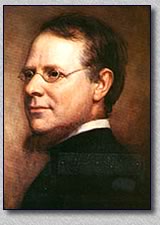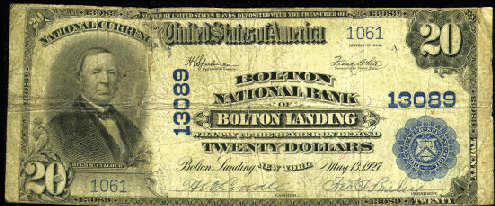Today we continue our interview with Fr. Ken McGuire, Director of St. Mary’s on the Lake, the Paulist’s headquarters in Lake George. Fr. McGuire is sharing what he knows about the Paulist islands across the lake form Huletts.

Fr. Isaac Hecker, the founder of the Paulists, is on path toward being officially recognized as a “Saint” by the Catholic Church. Does he have a connection to the islands or the area?
Fr. Hecker regularly visited the lake. A room next to the chapel in the main house was maintained for him. He, of course, visited the islands, but we have no exact dates for this. There is a letter indicating that he visited the main house in 1887 a year before he died.
It was Hecker’s connections that brought about the early Paulists to the Lake at O’Connor’s property. Fr. Hecker initiated the plan to purchase the islands. He personally drew up the plans for the main house which was constructed in 1877.
St. Mary’s on the Lake and Harbor Islands are the only place where every Paulist has lived at some point. Every other house including our Mother House at 59th and 9th in New York City have been visited but not necessarily been a place of residence for each Paulist. These properties are treasured places where healthy and holy men, from Hecker to the present, have walked, laughed and meditated.
There is also a house on one island, what do the Paulist’s use this for?
The early Paulists, after camping in tents for some years built and maintained two lean twos. The dock for that island moved from place to place until early in the 1930’s when it became stationary where it is at present.
In 1954 the students designed and built a cabin with kitchen/eating area divided from a bunk area. With double bunks it could accommodate up to 12 men at a time. Every student spent at least one week “on the islands”. Others spent more time for leisure or for work jobs, maintaining the facilities.
In 1983 three men were in the cabin including Fr. Elwood Keiser of “Insight Series” fame. They tried to preserve charcoal after a rainy day by storing it in the porch area. In the middle of the night it ignited and burned the cabin down. The three men escaped safely but all their personal items were destroyed.
The following year the Paulists hired a construction firm to rebuild the cabin as originally constructed. The dock used to be twice as long as now but it was always severely damaged by ice. Students spent a week or more doing repairs each spring. By the 1980’s, students spent only August at the Lake and the dock was shortened to its present length. It still was damaged yearly and had to be continually repaired.
In 1997, I built a second dock along side and constructed both so they are pulled out of the water in the winter and put back in the spring.
The house is currently used by Paulists priests for leisure or for private retreats. Some spend a day or two while some spend up to two weeks or more. The students use the islands during August. We now have propane lights added in 1958 by student donations and installation. This also accommodates a propane refrigerator and stove. Previously we had rowed to Huletts for ice as needed for the ice box.
The islands are opened up for use by our order in late May and closed in October. Over Columbus Day weekend we have a “foliage trip”. Those groups plan a trip to the islands and if it’s cold we eat inside, if it is warm we use the outdoors. We sit “on the rocks”, a point with a view down the lake and occasionally a brave priest will take an October swim. During summer months, swimming, canoeing, rowing and kayaking are popular.
Father, thank you for taking the time to tell us about the Paulists, before we finish could you tell us something about “your story?”
It has been a gift for me to be the current director. The summer of ’09 will be my 15th year as director and my 47th year of living at St. Mary’s and Harbor Islands. I am currently 78 years of age. I was raised a (general) Protestant in a small town in Ohio, Mason. I entered the U.S. Air Force in 1951 and in 1953 converted to Catholicism beginning another journey and another time.
After completing my service I returned to Ohio State University which has been interrupted. I completed a B.S. in 1956 and B.S. in 1958. I enrolled at Oregon State University at Corvallis where I was ABD in Plant Breeding when I entered the Paulists in Sept. 1960. Following the normal courses of study I was ordained in 1968 and completed my thesis and received the MA in Theology in 1970.
Trying to combine my scientific mind set and the classical studies was daunting. The Paulists let me pursue courses at Catholic University in Anthropology, which helped a great deal. I spent two summers working at the Mother House in New York. After ordination I spent a year working in our parish, St. Rose of Lima, in Layton, Utah after which I returned to Ohio State. I worked as a priest and a teaching assistant while pursuing my Ph.D. studies in Anthropology and after completing the dissertation was awarded the degree in 1976.
Much of my ministry has been spent in Campus Ministry; Ohio State, UCLA, University of California at Santa Barbara. I have been a pastor twice. I am now retired, we call it Senior Ministry Status, however I still am director at St. Mary’s on the Lake in the summer and I teach Cultural Orientation for Persons in Ministry (COPIM) through Loyola Marymount University in Los Angeles in the winter. This course is for priests or nuns who come from other cultures to work in the U.S.
My current residence is Lake George in the summer and Palm Spring, CA the rest of the year. As they say paradise in the summer and paradise in the winter.
For a farm boy in Ohio where I grew up, I’ve come a long way, way, way!
Thank you, Father Ken, for your very interesting interview. Please stop in and say hello to all of your friends in Huletts the next time you are up at the islands.
![]()









